With a varied list of contributors to Perfecting the Upset, we decided it made sense to start a series of articles where we’d throw out a question to the crew and see how they stand. This week, we ask:
What was the first game you ever attended?
(Don’t forget to check out our Allegiances table to know our loyalties.)
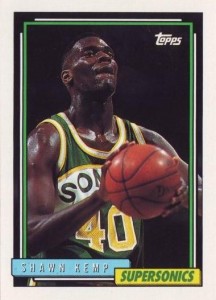
Rahat Ahmed
The first professional game I attended soon became part of one of my first memorable heartbreaks: Game 6 of the 1992-93 Western Conference finals between the Houston Rockets and the Seattle SuperSonics. My uncle surprised me with tickets, which led to me frantically printing out “banners” on our old dot matrix to cheer on Olajuwon and crew. (They were terrible, but an eleven year old has to make do with the technology he has access to.) The first five games of the series had been decided by an average of 14.4 points, all won by the team at home. Game 5, in fact, ended in a 25 slaughter by the Shawn Kemp-led Sonics.
The game was tight through half-time until Kenny “The Jet” Smith took it upon himself and ripped the Sonics 36-15 in the third quarter with his 13-for-16 shooting. We won 103-90. But the real memory of that series remains in two parts: The first was Game 7, which ended in a 3 point loss at Seattle in overtime. It was the only game in the series that went down to the wire, where The Jet had a chance to clinch it at the end of regulation but failed. We lost 103-100 because we simply couldn’t stop Sam Perkins. Brutal.
But what I’ve never forgotten was outside the series, and why I’ve come to hate David Robinson and the San Antonio Spurs so much: Game 82 of the regular season was against them. We won the game outright during regulation, but Hugh Evans decided to count a tip-in at the buzzer that was clearly too late. It was enough to send the game to overtime and help the Spurs eek out a 119-117 victory. Most importantly? It gave Seattle home court advantage against us, even though we both ended the season with the same record. And considering we were 2-6 against them over the past two seasons due to our inability to contain Kemp, Payton and Perkins, we could have used that. (Perkins, especially, was one of the few players in the league who gave Olajuwon problems due to his range and height.)
We know that one decision in the regular season doesn’t lead to your final seeding, but I’ve never been able to forget about it. My first experience at The Summit remains blood-stained by Robinson and Evan and kept us from having a go at Jordan.
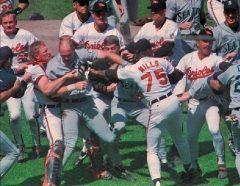
Nick Britton
I assume that the first sporting event I went to was a minor league baseball game but I don’t remember anything about it. And when I was a young’un I saw the Washington Bullets a couple of times and the Washington Capitals once. That’s all I remember.
The first game for which I remember any details was a Seattle Mariners/Baltimore Orioles game on June 6, 1993 at Camden Yards in Baltimore. The stadium was only about a year old then. I remember this game for a couple of reasons: One, my dad had procured access to the Tyson Chicken corporate luxury box, so I got to watch the game in style; and two, there was a giant brawl in the middle of the game.
The fight I remember well but the people involved faded from my memory over the past 18 years until a friend of mine found the box score for me. I knew Harold Reyonlds, Mike Mussina and Norm Charlton were involved and that Lou Piniella got thrown out for a temper tantrum. It was an epic fight by baseball standards, and it started as baseball fights usually do: Team A’s pitcher throws at or hits Team B’s batter and then Team B’s pitcher retaliates shortly thereafter. In this case, Chris Bosio of the M’s went headhunting and Mike Mussina of the O’s nailed some dude I’ve never heard of. Fight!
What I remember most was how the fight never seemed to end. Usually, these things end quickly and everyone’s standing around. The guys from the bullpen run in just to get some cardio in. But this fight just kept going on and on. The pile kept moving around the infield like those cups in that cup game they always throw up on the video board. Fights were breaking out all over the place. McNulty and Bunk tried to break things up until the umpires stopped them (the police did try to intervene). Apparently, Ripken was at the bottom of that mess. Everyone in the stadium was standing up just in awe of a real, honest-to-god fight on the baseball diamond. I was pretty sure it was the greatest thing I’d seen in my 14 years of life so far.
The end result: Chris Bosio broke his collarbone for the second time that season. Two guys on the O’s got all bloodied up. Norm Charlton threw some punches. Eight players were ejected, including Piniella (shocker).
I only knew who won thanks to the box score. But two teams brawling out all over the diamond, that’s the kind of thing that sticks with you. The only equivalent would be Pedro Martinez throwing Don Zimmer to the ground like a bag of flour. But I wasn’t there for that.
Oh, and Cal Ripken? Ripken lived to see another day (or so).
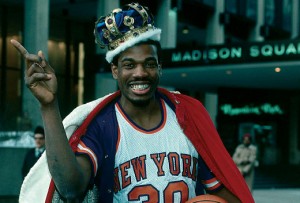 Andrew Feingold
Andrew Feingold
Technically, the first game I ever went to was Rockets vs. Knicks at Madison Square Garden on December 3, 1983, when my mom was pregnant with me. When I was old enough to hear this story, I instantly became a Knicks fan. During the 1983-84 season, the Knicks finished 47-35 and lost in the Eastern Conference Semifinals to the Celtics. As a Knicks fan, this was just the beginning of losing series to playoff rivals. Hubie Brown was the coach of the team at the time, and to this day he remains one of my favorite announcers to hear on the radio.
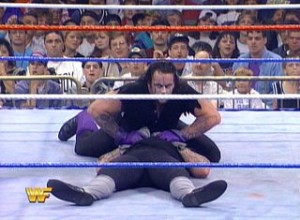
C.D. Hale
Survivor Series ’94. San Antonio. Freeman Coliseum. I was 12, and our poor asses smuggled food in from the outside, a pseudo-white trash family of four taking in the ‘rasslin for the night. Couldn’t have enjoyed it more, particularly when Undertaker extracted revenge by defeating Yokozuna in a casket match. The special enforcer for that main event match? A Mr. Chuck Norris, the man who doesn’t read books, but rather, stares them down until he gets the information he wants.
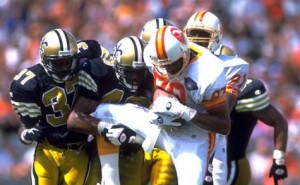
Sean Koo
In September ’94, my dad took my brother and me to our first Buccaneers game. It was at the Old Sombrero against the New Orleans Saints, and little did I know that this would be the start of my hatred of the ‘Aints. In the midst of the Bucs’ thirteen year run of losing seasons, Sam Wyche was trying to put a consistent winner out on the field, but even his Super Bowl resume couldn’t get it done in Tampa. In a game that you could call a “defensive showdown” or an “offensive letdown,” the Bucs lost to the Saints 9-7. It would be a couple of more games until I saw my first win, and years until my first winning season, but being in the stadium for the first time and taking in the experience in all of its smash-mouth-football glory had me hooked. Buccaneer football at the Old or New Sombrero was the only way to go.
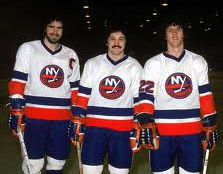
Sreesha Vaman
My first sporting event was a Capitals regular season game against the Minnesota North Stars in 1987, but it wasn’t the first one I was supposed to go to.
On November 1, 1985, my Capitals hosted an early-season home game against the New York Islanders—those New York Islanders, who had won four straight Stanley Cups and came one win away from a fifth. Bossy. Trottier. Smith. Potvin. Gillies. LaFontaine. Two Sutters. Tonelli. A stacked line-up, one of the greatest teams ever assembled in the NHL.
So needless to say I was excited for weeks when my friend told me that his dad got four tickets to the game from work, and I was getting the fourth ticket.
The day before the game, I stayed out playing night roller hockey with my friends in the cold Indian summer air wearing a t-shirt and shorts… and got sick. I could barely move the next morning. I skipped school, slept as much as I could, but couldn’t convince my mom I was healthy enough to go to the game.
The 4pm vomiting didn’t help my cause.
At 5pm I succumbed, and another friend went to the game. I watched the Caps beat the Isles, 5-3, on television. My friend’s dad brought me a Capitals team calendar, which was the promotion that night.
Missing that game was a source of inspiration from then on, though: I watched every minute of every Capitals game on TV (unless I went to the game in person) from that year until I went to college outside of the DC area 12 years later.
In my junior and senior year, there was some home tape-delaying involved since I was working, playing club hockey, and, for a little bit, entertaining a girlfriend who wasn’t a sports fan; go figure—but I made it happen.
Still, I wondered how great it would have been to see my Caps perfect the upset (pun intended!) against the vaunted 1980s Islanders.
I still am jealous to this day.
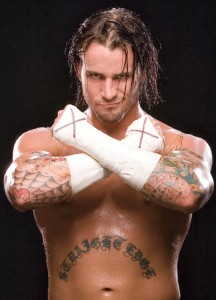 On the other hand, perhaps Punk is best suited to shine as a lone wolf in professional wrestling’s modern-day, toned-down, PG-rated era, where “superstars” (i.e., politically correct merchandise movers) like John Cena, Kofi Kingston and Rey Mysterio curry more favor than do malcontents like Punk. In 2011, Punk’s rebellious tone, “voice of the voiceless” mantra, and underdog backstory have fused together to create what is unquestionably wrestling’s biggest “lightning in a bottle” movement since Austin captivated viewers more than a decade ago with his brash, no-nonsense style. In fact, Punk is appealing to those very same fans, many of whom moved on from WWE when Attitude Era stars like Austin and Rock exited stage left.
On the other hand, perhaps Punk is best suited to shine as a lone wolf in professional wrestling’s modern-day, toned-down, PG-rated era, where “superstars” (i.e., politically correct merchandise movers) like John Cena, Kofi Kingston and Rey Mysterio curry more favor than do malcontents like Punk. In 2011, Punk’s rebellious tone, “voice of the voiceless” mantra, and underdog backstory have fused together to create what is unquestionably wrestling’s biggest “lightning in a bottle” movement since Austin captivated viewers more than a decade ago with his brash, no-nonsense style. In fact, Punk is appealing to those very same fans, many of whom moved on from WWE when Attitude Era stars like Austin and Rock exited stage left.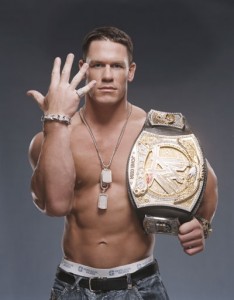 The buildup to this bout has been textbook. Both Punk and Cena have starred in their respective roles—Punk as the lifelong underdog who came up on the independent scene and values championships over merchandise sales and wrestling over sports entertainment; Cena the corporate face who moves more merchandise than any wrestler in the game today. They have torn down the “fourth wall”—code for what goes on behind the scenes in professional wrestling—and have referenced previous real-life confrontations, fired wrestlers, corporate cronies, wives, girlfriends. the list goes on.
The buildup to this bout has been textbook. Both Punk and Cena have starred in their respective roles—Punk as the lifelong underdog who came up on the independent scene and values championships over merchandise sales and wrestling over sports entertainment; Cena the corporate face who moves more merchandise than any wrestler in the game today. They have torn down the “fourth wall”—code for what goes on behind the scenes in professional wrestling—and have referenced previous real-life confrontations, fired wrestlers, corporate cronies, wives, girlfriends. the list goes on.






 10. Ray Lewis, LB, Baltimore Ravens: Yeah, Ray has lost a step. In fact, he’s probably only the third or fourth best player on his own defense at this point. That said, if it goes down, give me someone such as Ray-Ray, a wily vet with a noted mean streak, a ripped physique, unmatched intensity and an innate leadership quality. Plus, tell me
10. Ray Lewis, LB, Baltimore Ravens: Yeah, Ray has lost a step. In fact, he’s probably only the third or fourth best player on his own defense at this point. That said, if it goes down, give me someone such as Ray-Ray, a wily vet with a noted mean streak, a ripped physique, unmatched intensity and an innate leadership quality. Plus, tell me 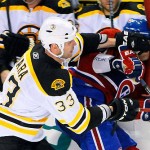 9. Zdeno Chara, Defenseman, Boston Bruins: I don’t pretend to know much about hockey, but I do know that anytime a guy
9. Zdeno Chara, Defenseman, Boston Bruins: I don’t pretend to know much about hockey, but I do know that anytime a guy 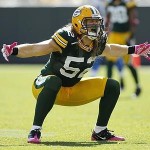 8. Clay Matthews, Linebacker, Green Bay Packers.
8. Clay Matthews, Linebacker, Green Bay Packers. 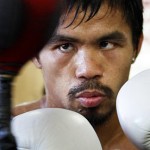 7. Manny Pacquiao, Boxer/Politician: The reasoning for this is simple … boxing is a sport in which success is measured by one’s ability to pummel his opponent into submission with his fists. No one in the world does this better than “Pac-Man.” Let’s move on.
7. Manny Pacquiao, Boxer/Politician: The reasoning for this is simple … boxing is a sport in which success is measured by one’s ability to pummel his opponent into submission with his fists. No one in the world does this better than “Pac-Man.” Let’s move on.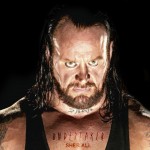 6. The Undertaker, Professional Wrestler/Dead Man: Think it’s fake, huh? Try telling that to this 7-foot, 300-plus-pound Houstonian behemoth who, by the way, also trains in mixed martial arts. Plus, his 19-0 record at WrestleMania is professional wrestling’s 56-game hitting streak.
6. The Undertaker, Professional Wrestler/Dead Man: Think it’s fake, huh? Try telling that to this 7-foot, 300-plus-pound Houstonian behemoth who, by the way, also trains in mixed martial arts. Plus, his 19-0 record at WrestleMania is professional wrestling’s 56-game hitting streak.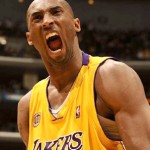 5. Kobe Bryant, Guard, Los Angeles Lakers: He’s not intimidating in terms of pure physical force, but Bryant’s intensity, work ethic and will to prevail on the court are second only to one Michael Jordan. Personally, that frightens me, if only because it indicates that Kobe is the type to sneak a shiv into a fists-only streetfight.
5. Kobe Bryant, Guard, Los Angeles Lakers: He’s not intimidating in terms of pure physical force, but Bryant’s intensity, work ethic and will to prevail on the court are second only to one Michael Jordan. Personally, that frightens me, if only because it indicates that Kobe is the type to sneak a shiv into a fists-only streetfight.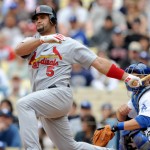 4. Albert Pujols, First Baseman, St. Louis Cardinals: By all accounts a good guy on and off the diamond, Pujols nonetheless looks like the meanest bouncer at the bar, the guy who spent all day working out in the hopes of inciting a riot later that night. His muscles have muscles. Hell,
4. Albert Pujols, First Baseman, St. Louis Cardinals: By all accounts a good guy on and off the diamond, Pujols nonetheless looks like the meanest bouncer at the bar, the guy who spent all day working out in the hopes of inciting a riot later that night. His muscles have muscles. Hell, 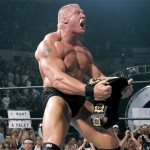 3. Brock Lesnar, UFC Heavyweight/Ill-Tempered Minnesotan: No, Brock Lesnar is not an elite UFC competitor, at least not on par with the Anderson Silvas of the cage fighting world. That said,
3. Brock Lesnar, UFC Heavyweight/Ill-Tempered Minnesotan: No, Brock Lesnar is not an elite UFC competitor, at least not on par with the Anderson Silvas of the cage fighting world. That said, 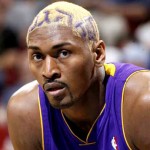 2. Ron Artest (aka Metta World Peace), Forward/Resident Lunatic, Los Angeles Lakers: The eyes don’t lie. Whether it’s that formerly-crazy girlfriend who alleges to have changed her ways, or a former
2. Ron Artest (aka Metta World Peace), Forward/Resident Lunatic, Los Angeles Lakers: The eyes don’t lie. Whether it’s that formerly-crazy girlfriend who alleges to have changed her ways, or a former 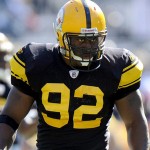 1. James Harrison, Linebacker/Gun Enthusiast/Disgruntled NFL Employee, Pittsburgh Steelers: Easy call. Harrison is a 6-foot, 250-pound, mean-spirited, hard-hitting, gun-toting madman. A former Defensive Player of the Year,
1. James Harrison, Linebacker/Gun Enthusiast/Disgruntled NFL Employee, Pittsburgh Steelers: Easy call. Harrison is a 6-foot, 250-pound, mean-spirited, hard-hitting, gun-toting madman. A former Defensive Player of the Year, 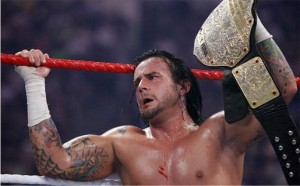 Punk followed
Punk followed 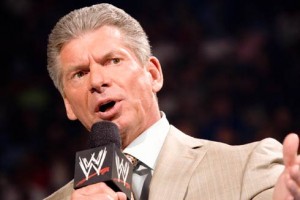 It’s all an act, part of a grand tale tailored to move merchandise, sell pay-per-views and increase hits on the WWE website. It’s also based in reality, something WWE has largely avoided since superstars like Austin, The Rock, Bret Hart and Shawn Michaels rose to prominence, essentially, by playing themselves on camera.
It’s all an act, part of a grand tale tailored to move merchandise, sell pay-per-views and increase hits on the WWE website. It’s also based in reality, something WWE has largely avoided since superstars like Austin, The Rock, Bret Hart and Shawn Michaels rose to prominence, essentially, by playing themselves on camera.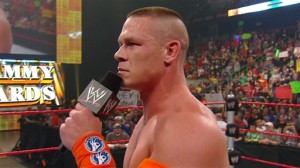 That is, until Monday, June 27, when Punk changed the course of his character and, temporarily at least, the professional wrestling landscape, with a pitch-perfect promo that highlighted WWE’s ills, his frustrations with the behind-the-scenes politics and the fact that the organization now favors “superstars” over actual “wrestlers.” Gone was the character Punk had been portraying for the past few years. On display was the raw emotion brought forth by a man who knew he—and WWE’s paying customers—deserved better.
That is, until Monday, June 27, when Punk changed the course of his character and, temporarily at least, the professional wrestling landscape, with a pitch-perfect promo that highlighted WWE’s ills, his frustrations with the behind-the-scenes politics and the fact that the organization now favors “superstars” over actual “wrestlers.” Gone was the character Punk had been portraying for the past few years. On display was the raw emotion brought forth by a man who knew he—and WWE’s paying customers—deserved better.